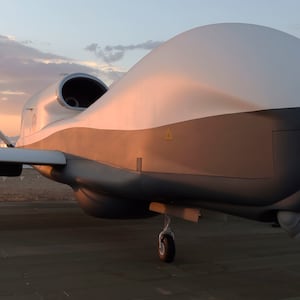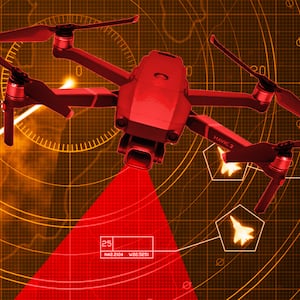Is a downed drone the final straw that will push the U.S. to war with Iran? Iran’s attack on an unmanned surveillance aircraft in the Gulf on Wednesday seems like the kind of opening Trump’s hawkish advisors would use to argue for a strike back at a trouble-making Tehran. Trump himself doesn’t seem too worked up about the incident and suggested the attack could’ve been a “mistake.” So whose argument will win the day? Just how dangerous is Iran’s latest drone hunt outing and what else should we expect from Tehran’s attempts to push back on America’s “maximum pressure” campaign?
Welcome to Rabbit Hole.
Red lines: Trump started the morning with a cryptic and seemingly ominous tweet that “Iran made a very big mistake!” in shooting down an American drone on Wednesday. Later in the day, it became clear that he meant it a somewhat less threatening sense. “I think probably Iran made a mistake. I would imagine it was a general or somebody that made a mistake in shooting that drone down and fortunately that drone was unarmed. There was no man in it,” he told reporters during a meeting with Canadian Prime Minister Justin Trudeau. Trump also seemed to differentiate between Iranian attacks on unmanned aircraft and U.S. troops in terms of severity, saying an attack on manned aircraft “would've made a big, big difference” in how the U.S. responded.
ADVERTISEMENT
The president has seemed to have little appetite for conflict with Iran ever since Iranian forces allegedly attacked oil tankers in the Gulf. He reportedly told staffers to tone down their rhetoric and referred to the tanker attacks as “very minor” in a Time magazine interview. But his advisors are a different issue. National security adviser John Bolton has long pushed for more confrontation with Iran, and CNN reported that in discussions with Trump today, Bolton is still pushing for a hardline while Secretary of State Mike Pompeo has sought out a middle ground between Bolton and Trump’s war wariness.
Missile level-up: The missile system that Iran claimed it used to take out the U.S. Navy Broad Area Maritime Surveillance Demonstrator, or BAMS-D on Wednesday is known as the 3rd Khordad—basically Iran’s spin on the Soviet-vintage Buk missile system. The Buk was designed to hit targets at altitudes of 15-20 miles. Iran generally fibs about the capabilities of its homegrown systems, but the fact that the 3rd Khordad was able to reach out and touch an aircraft like the BAMS-D, which was flying at around 22,000 feet, shows it’s at least in the same ballpark as its Soviet cousin.
It’s an altogether more capable missile than the one Iran allegedly used to take a potshot at an American Reaper drone flying over a burning tanker last week. In that incident, U.S. Central Command claimed that the missile fired was an SA-7.
It missed, and that’s not a big surprise. The SA-7 is a shoulder-fired, man-portable surface-to-air missile that dates back to the '60s, can only reach about 8,000 feet. "Generally speaking, SA-7 pattern MANPADS are lousy weapons, especially when compared to more recently fielded systems,” Matt Schroeder, an expert in man-portable surface-to-air systems, told The Daily Beast. “The SA-7 is slower and has a shorter range, a less sophisticated seeker, and a smaller warhead. Furthermore, most are way past their 'sell by' date and may not function as intended (or at all).”
Flying the unfriendly skies: The higher-reaching altitude of the missile used in the BAMS-D downing, even though no humans were harmed in the robot downing, has piqued the concern of U.S. military officials. If the “Buk” name sounds familiar, it should. A Buk missile system was what Russian soldiers used when they shot down a Malaysian airliner, MH17, they mistook for a Ukrainian military plane flying over the skies of rebel-held eastern Ukraine in 2014.
Lt. Gen. Joseph T Guastella, the commander in charge of U.S. air forces, blasted the attack. “This dangerous and escalatory attack was irresponsible and occurred in the vicinity of established air corridors between Dubai, UAE and Muscat, Oman, possibly endangering innocent civilians,” he told reporters in a televised statement on Thursday.
The bad old days: The prospect of a missile going awry or someone accidentally targeting a civilian airliner is all too familiar historical scenario. Some historians would point to Korean Air Lines Flight 007, a Korean airliner which Soviet forces mistook for a provocative U.S. spy plane flight into Soviet airspace and shot it down, as an example of the kind of dangers that come from tense international standoffs that cross into heavily trafficked airspace.
But there’s another, eerily familiar precedent which haunts the current U.S.-Iran tensions in the Gulf. In the '80s, the U.S. and Iran were similarly at each other’s throats during another standoff over oil tankers. Iran and Iraq attacked each other’s oil shipments, and Iran expanded its targets to include Kuwaiti-flagged tankers. The move prompted the U.S. Navy to escort the tankers and led Iran to mine the Gulf, damaging U.S. Navy vessels, and triggering small-scale clashes with U.S. forces.
The tit-for-tat fighting in the Gulf made for itchy trigger fingers and one day in 1988 the USS Vincennes fired a surface-to-air missile at what it thought was an Iranian fighter jet. The aircraft wasn’t a fighter jet but a civilian airliner, Iran Air 655, and the attack killed all 290 men, women, and children on board. The incident only heightened tensions between the U.S. and Iran, so much so that some initially suspected the Libyan bombing of Pan Am Flight 103 over Lockerbie, Scotland might have been Iranian retaliation for the loss of Iran Air 655.
Mischief sweet spot: If you step back and look at the actions that Iran and its proxy groups are accused of taking since early May, it follows a certain logic. Iran wants to push back on increasing pressure of the Trump administration’s sanctions campaign since April but doesn’t want to push back so hard that it invites a military attack from the administration. So how do you get the porridge just right? Iran has allegedly targeted American allies in Europe and Asia (two Norwegian tankers and one Japanese tanker hit by limpet mines), used Houthi allies to launch a wave of drone and cruise missile attacks on Saudi energy facilities and airports, fired missiles at American drones in the Gulf, and launched small artillery near bases where U.S. military troops are stationed in Iraq.
In other words, it looks like Iran is trying to use its military and proxies to hurt America without trying to hit Americans. That’s in keeping with the message Secretary of State Mike Pompeo delivered to Iran. The Washington Post reported that Pompeo sent a message to Iranian leaders letting them know that any attack by Iran or its proxies that killed a U.S. service member would trigger a military response.







